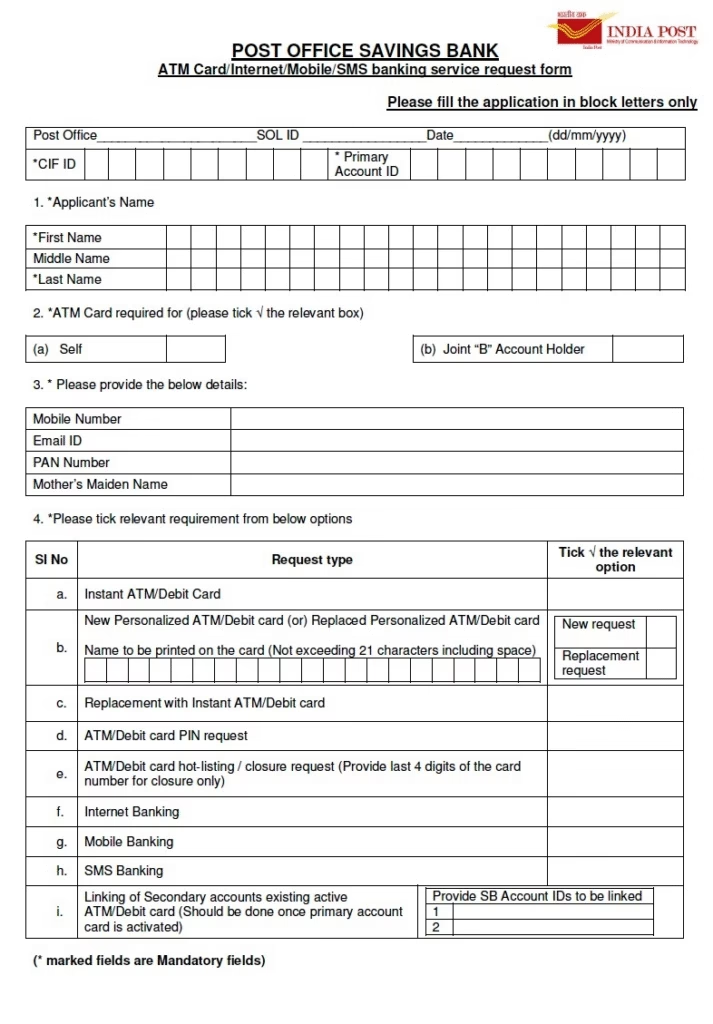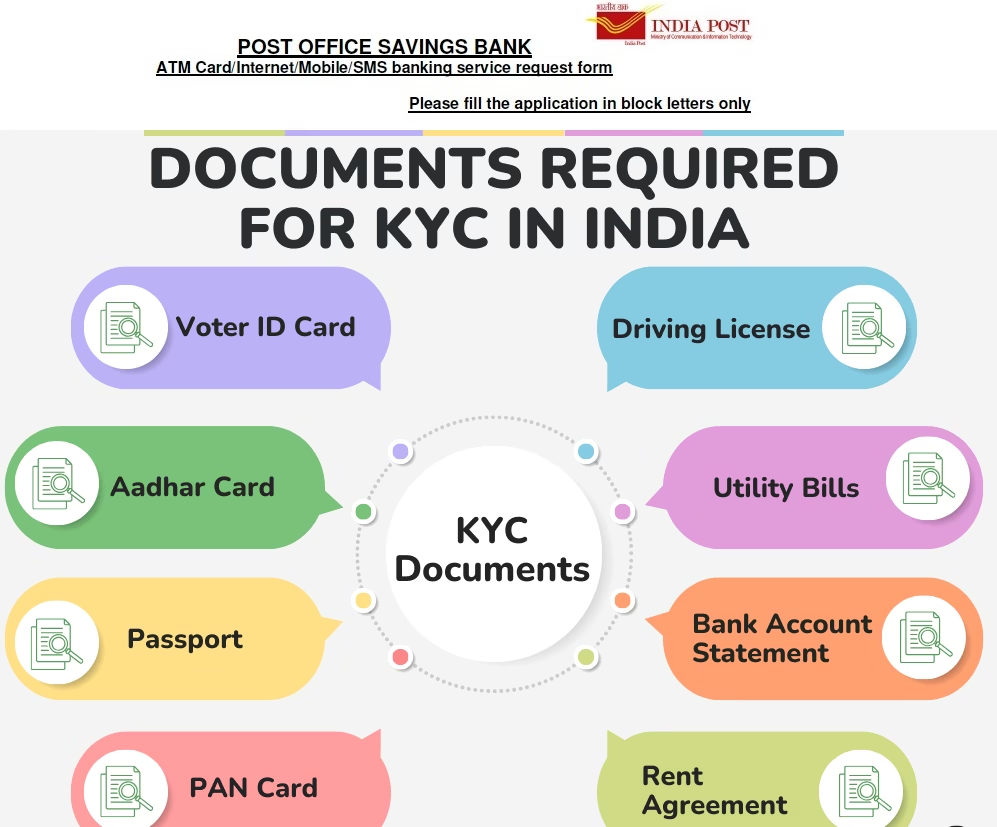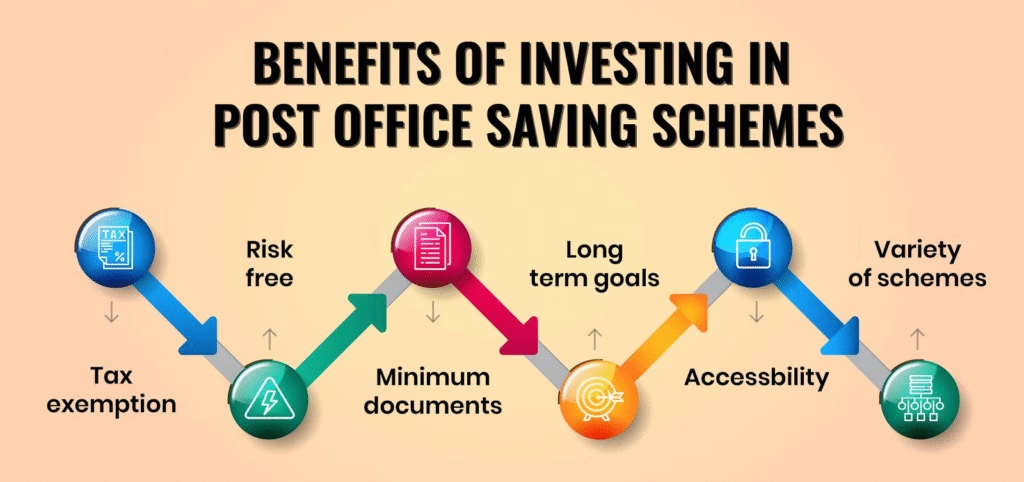Post Office Saving Schemes 2025: Through a number of programs, including the Public Provident Fund (PPF), Senior Citizen Savings Scheme (SCSS), and Monthly Income Scheme (MIS), Post Office investment-savings schemes in India provide risk-free returns. Additionally, under Section 80C of the Income Tax Act, they provide tax benefits up to Rs.1.5 lakh. With the arrival of Q-2, the interest rates of the Post Office Saving Schemes are updated. Recently the government published the interest rates for various small savings schemes, including PPF and NSC.
It will remain the same for the sixth consecutive quarter starting from July 1, 2025. As per the new changes the investments of Sukanya Samriddhi scheme will earn an interest rate of 8.2 percent, 7.1% for the three years of term deposit as same as the previous quarter.
Post Office Savings Schemes Overview
| Small Savings Scheme | Interest Rate | Tenure | Tax Deduction on Investment? | Interest Taxable |
| Post Office Savings Account | 4.0% | NA | No | Yes |
| Post Office Recurring Deposit | 6.7% | 5 Years | No | Yes |
| Post Office Monthly Income Scheme | 7.4% | 5 Years | No | Yes |
| Post Office Time Deposit (1 year) | 6.9% | 1 Year | No | Yes |
| Post Office Time Deposit (2 year) | 7% | 2 Years | No | Yes |
| Post Office Time Deposit (3 year) | 7.1% | 3 Years | No | Yes |
| Post Office Time Deposit (5 year) | 7.5% | 5 Years | Yes | Yes |
| Kisan Vikas Patra (KVP) | 7.5% | 30 Months Lock-in period | No | Yes |
| Public Provident Fund (PPF) | 7.1% | 15 Years | Yes | No |
| Sukanya Samriddhi Yojana | 8.2% | 21 Years | Yes | No |
| National Savings Certificate | 7.7% | 5 Years | Yes | No |
| Senior Citizens Savings Scheme | 8.2% | 5 Years | Yes | Yes |
Post Office Saving Schemes Account
As same as the savings account of other banks, a postal savings account is also manages the money of people. One person can have only one account at a single post office, it can be transferred to another post office if needed. Post office rd scheme 1,000 per month minor can open an account there. A minimum of Rs. 50 is applicable to be remain as a balance if one applicant wants a non-cheque facility. Post office monthly income scheme one can claim a deduction of Rs. 10,000 per year on their total savings account interest.
Types of Post Office Saving Schemes under Postal Bank
- Post Office Saving Account: This works like a normal savings account operated in many banks. There is no TDS. You can open only one account and it is transferable in between the branches.
- Post Office Recurring Deposit: This is a five-year fixed-term monthly investment plan. The interest rate on RD for FY 25-26 is 6.7% currently. It helps the investors who wants to make investment with small amount of money monthly. You can withdraw at least 50% of your deposit after one year of the investment made.
- Post Office Monthly Income Scheme: It offers a fixed guaranteed income if anyone is investing a large amount of money. Minimum limit of investment is Rs. 1000 and maximum is 9 lakhs for single account holders and 15 lakhs for joint account holders. The interest rate is 7.4%. No major tax benefit is there having the scheme.
- Post Office Time Deposit: The features of this account is as same as other accounts but with a speciality that after a certain period of time the time deposit will get matured and then it will be renewed automatically for the same duration. The income tax act’s 80C also applies to the deposit made under this scheme. Interest rates varies year wise.
- Senior Citizens’ Saving Scheme or SCSS: is a program designed specifically for senior citizens. The voluntary retired person can also apply. The limit of investment is up to 30 lakhs. 8.2% is the current interest rate and the maturity of the scheme is 5 years and also the applicant can extend the scheme up to 3 years. This is taxable under 80c.
- PPF or Public Provident Fund: It is a long term investment scheme with a duration of 15 years with an interest rate of 7.1%. Investment limit is up to 1.5 lakhs. It gives the tax benefit of 1.5 lakhs.
- National Savings Certificate or NSC: NSC is a tax benefited risk free saving scheme with a maturity of 5 years having an interest rate of 7.7%. Investments in the Rs. denomination are possible. 100, Rs. 500 or so on. These are transferable.
- SSY or Sukanya Samriddhi Yojana: This scheme is designed to secure the life of the girl child with an interest rate of 8.2%. It will mature after 21 years. Rs.1000 is the minimum investment and maximum of Rs. 1, 50,000. Only the girl can close the account for marriage or studies only. This scheme can also avail a tax benefit under 80C.
- KVP or Kisan Vikas Patra: This is a liquid certificate which doubles the amount in every 115 months. The minimum amount is Rs, and the interest rate is 7 percent. 1000. The certificates are easily transferable. The principal amount cannot avail the tax benefit.
Latest Update on Post Office Saving Schemes 2025
The Post Office Saving Schemes for 2025 continue to offer stable, government-backed returns and easy access for all categories of depositors, with the central government keeping the interest rates unchanged for the sixth consecutive quarter beginning July 1, 2025. This means investors can rely on previously announced rates, including 8.2% for Sukanya Samriddhi Yojana and Senior Citizens Savings Scheme, 7.1% for Public Provident Fund and 3-year Time Deposit, 7.7% for National Savings Certificate, and 7.4% for the Monthly Income Scheme.
Each scheme is designed to address varied financial needs—ranging from daily savings and monthly incomes to future planning for children or retirement. Importantly, PPF, SSY, NSC, and 5-year Time Deposits provide strong tax benefits under Section 80C, with tax-exempt interest in PPF and SSY, making them highly attractive for tax-saving investments. Kisan Vikas Patra retains its 7.5% rate and unique doubling feature—ideal for those focused on capital growth over longer periods.
Important Dates for 2025
| Event | Date | Details |
| Q1 Rate Review | April 1, 2025 | Rates for April-June announced; no changes from previous. |
| Q2 Rate Review | July 1, 2025 | Current rates (July-Sep) set at stable levels like 8.2% for SCSS. |
| Q3 Rate Review | October 1, 2025 | Upcoming announcement—watch for potential hikes. |
| PPF Maturity Extensions | Anytime after 15 years | Flexible rollover options effective throughout 2025. |
| SSY Account Opening Deadline | March 31, 2025 (for FY) | Annual deposit limit resets April 1. |
How to Invest Post Office Saving Schemes
- To select the scheme that fits your goals short-term, long-term, or for your kids.

- Go to the your nearest post office. Most branches, even in small towns, offer these schemes.

- Then fill the application form for your chosen scheme. You’ll need to provide basic details like your name, address, and bank account info.

- To Submit the document your Aadhaar card, PAN card, and a passport-sized photo. Some schemes may require additional proof, like age proof for SCSS.

- To Deposit your money, You can pay via cash, cheque, or demand draft. Some post offices now accept digital payments too.

- Go the Your Passbook on your account is opened, you’ll receive a passbook to track your investments.

- To Many schemes now offer online access through India Post’s mobile app or website, so you can check your balance from home.
National Overseas Scholarship 2025 Apply Online, Last Date, Documents & Selection Criteria
Benefits Of Post Office Saving Schemes
The application process of investing in postal saving schemes is very simple. It needs a less paperwork. These savings schemes secure investment options that guarantee a fixed return, as these are regulated by the government itself. Both the investors of rural and urban areas can avail the schemes easily as these are flexible and not that complicated.
The investing schemes provided by the Post Office is more futuristic and meant of serving long-term benefits. These benefits are serving as excellent retirement or pension plans, with investment periods lasting up to 15 years for a PPF account. The investors are able to diversify their portfolios without taking any risk and also they are getting stable return out of it. They interest rates ranging from 4% to 8%, which is also risk-free and very competitive compared to banks.

Schedule Fee of Post Office Saving Schemes
The schedule fee of Post office Investment Schemes are as follows:
| Duplicate Passbook Issue | Rs. 50 |
| Deposit Receipt or Issue of Statement of Account | Rs. 20/case |
| Issue of Passbook in Lieu of Lost or Mutilated Certificate | Rs. 10 per registration |
| Cancellation or Change of Nomination Charges | Rs. 50 |
| Account Transfer Fee | Rs. 100 |
| Pledging of Account | Rs. 100 |
| Issue of Cheque Book (for Savings Bank a/c) | Nil: Up to 10 leafs in a calendar yearRs. 2 per cheque leaf thereafter |
| Cheque Dishonour Charges | Rs. 100 |
Documentation For Post Office Saving Schemes
To open a postal saving scheme, the applicant need to present these documents before the bank. The documents are the completed or filled form, A KYC form, the applicant’s Aadhaar card, the applicant’s PAN card, Passport size photos, residence proof, nomination form and proof of birth in case of a minor.
Investment Process: Post Office Saving Schemes
If you want to invest in any of the schemes then visit your nearest post office branch and chose the scheme you want to invest. Get the account opening form and fill it. Attach the KYC proofs and other necessary documents. Then open your account by depositing the minimum amount of the scheme and chose your scheme wisely by knowing or comparing the benefits.
FAQs about How to Invest Post Office Saving Schemes
Are these schemes safe?
Yes, fully government-backed, no risk of losing your principal.
Can I open online?
Partially, use the India Post portal for some, but visit a branch for full setup.
What’s the best for taxes?
PPF and SSY offer full tax-free returns under 80C.
Do rates change often?
Reviewed quarterly, but usually stable. Check official sites.

